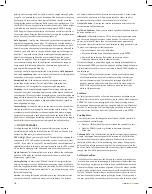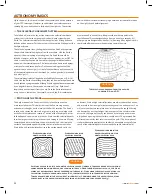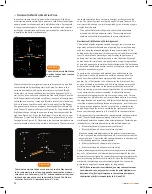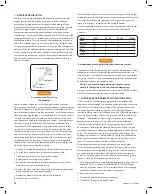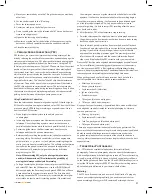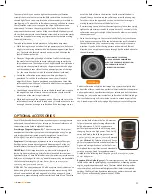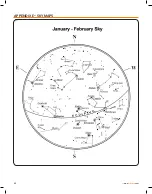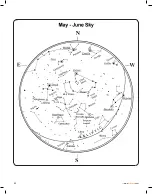
28
>>
www
.celestron
.com
metering which lets you know if your picture is under or overexposed .
Adjustments for proper exposures are made by changing the shutter
speed. Consult your camera’s manual for specific information on
metering and changing shutter speeds
Reducing Vibration
Releasing the shutter manually can cause vibrations, producing blurred
photos . To reduce vibration when tripping the shutter, use a cable
release . A cable release keeps your hands clear of the camera and lens,
thus eliminating the possibility of introducing vibration . Mechanical
shutter releases can be used, though air-type releases are best . Blurry
pictures can also result from shutter speeds that are too slow . To prevent
this, use films that produce shutter speeds greater than 1/250 of a second
when hand-holding the lens. If the lens is mounted on a tripod, the
exposure length is virtually unlimited .
Another way to reduce vibration is with the Vibration Suppression Pads
(#93503) . These pads rest between the ground and tripod feet . They
reduce the vibration amplitude and vibration time .
The following is a brief description of the advantages of imaging at each
f-number configuration and the proper equipment needed to use the
telescope in any of its many settings
f/6.3 with Reducer/Corrector
When imaging some objects like planetary nebula (for example M57, the
Ring Nebula) and small galaxies (M104, the Sombrero Galaxy), larger
image scale is needed to resolve finer detail. These objects are better
shot at f/6.3 or even f/10.
Medium size to small galaxies – f/6.3 imaging gives you finer resolution
then at f/2, but the slower f-number will usually require you to guide
the image while you are taking longer exposures . Guiding can be
accomplished by using an optional Radial Guider or a piggyback guide
scope . The exposure times are about 10 times longer, but the results can
be worth the extra effort. There are some objects that are small enough
and bright enough that they work great at f/6.3. M104 (the Sombrero
Galaxy) can be imaged under dark skies with a series of short exposures
using Track and Accumulate . Ten exposures at 15 seconds each will yield
a nice image and is short enough that you may not need to guide the
exposure at all. For f/6.3 imaging, the optional Reducer/Corrector is
needed. (See Optional Accessory section at the end of this manual).
Lunar or small planetary nebulae – f/10 imaging is more challenging for
long exposure, deep-sky imaging . Guiding needs to be very accurate and
the exposure times need to be much longer, about 25 times longer than
f/2. There are only a select few objects that work well at f/10. The Moon
images fine because it is so bright, but planets are still a bit small and
should be shot at f/20 . The Ring Nebula is a good candidate because it is
small and bright. The Ring Nebula (M57) can be imaged in about 30-50
seconds at f/10 . The longer the exposure, the better .
Planetary or Lunar – f/20 is a great way to image the planets and
features on the Moon . When imaging the planets, very short exposures
are needed . The exposure lengths range from .03 to .1 seconds on
planetary images. Focus is critical as is good atmospheric conditions.
Generally you will take one image after another until one looks good .
This is due to the atmospheric “seeing” conditions. For every 10
exposures you might save 1 . To image at f/20, you need to purchase a 2x
Barlow and a T-adapter or Radial Guider .
>>
CCD Imaging
Fastar Option – Using your EdgeHD telescope at f/2 with optional
lens assembly.
The EdgeHD telescopes are equipped with a removable secondary
mirror that allows you to convert your f/10 telescope into an f/2 imaging
system capable of exposure times 25 times shorter than those needed
with a f/10 system! The Fastar compatible telescope’s versatility allows it
to be used in many different f-number configurations for CCD imaging,
making it the most versatile imaging system available today . With an
optional lens assembly you can easily convert your Fastar compatible
telescope to f/2 prime focus use in a matter of seconds . This makes the
system ideal for imaging deep-sky objects as well as planetary detail.
Described below is the configuration of each f-number and the type of
object best suited to that kind of imaging.
FIGURE 8-5
The Fastar Compatible
Optical System
The above figure shows how the secondary mirror is removed when
using the optional CCD camera for f/2 imaging .
Warning: The secondary mirror should never be removed unless
installing the optional f/2 lens assembly. Adjustments to collimation
can easily be made by turning the screws on the top of the secondary
mirror mount without ever having to remove the secondary mirror (see
Telescope Maintenance section of this manual) .
The f/# stands for the ratio between the focal length and the diameter
of the light gathering element. For example, the EdgeHD 11” optical
tube has a focal length of 110 inches and a diameter of 11 inches . This
makes the system an f/10, (focal length divided by diameter) . When
the secondary is removed and the CCD camera is placed at the Fastar
position, the system becomes f/2 . This is a unique feature to some
Celestron telescopes (see figures below).
Secondary
Mirror
Retaining
Ring
Secondary Mirror
Mount Handle
Corrector Plate
Secondary
Mirror
FIGURE 8-6
FIGURE 8-7
f/2 Lens Assembly
CCD Camera
Summary of Contents for 11007
Page 1: ...InstructionManual 11007 11008 11009...
Page 2: ...www celestron com...
Page 40: ...38 www celestron com APPENDIXD MAPSOFTIMEZONES...
Page 41: ...www celestron com 39...
Page 42: ...40 www celestron com APPENDIXE SKYMAPS...
Page 43: ...www celestron com 41...
Page 44: ...42 www celestron com...
Page 45: ...www celestron com 43...
Page 46: ...44 www celestron com...
Page 47: ...www celestron com 45...



